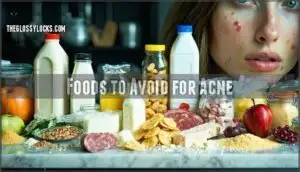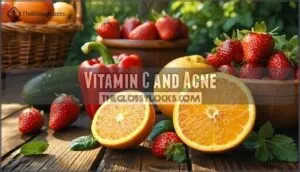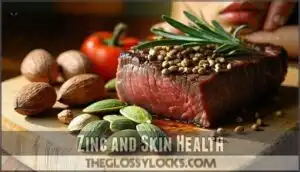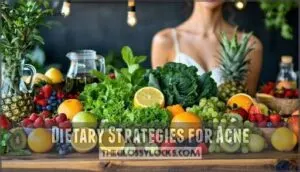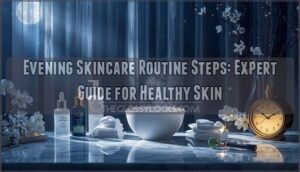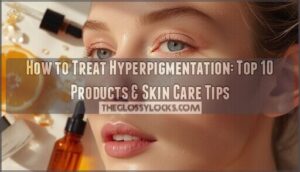This site is supported by our readers. We may earn a commission, at no cost to you, if you purchase through links.
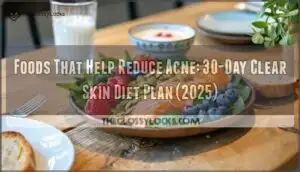
These powerhouse nutrients work like internal skincare, reducing inflammation and controlling oil production.
Green leafy vegetables provide essential vitamins that support skin repair, while probiotic foods like yogurt balance your gut bacteria, which directly impacts your complexion.
Think of your plate as your medicine cabinet – every anti-inflammatory food you eat is working overtime to calm breakouts from within.
The connection between diet and clear skin isn’t just wishful thinking; it’s backed by solid research showing measurable improvements in acne severity and the importance of a balanced diet for overall skin health, making it a complete concept in skincare.
Table Of Contents
- Key Takeaways
- Foods That Reduce Acne
- Best Foods for Acne Skin
- Foods to Avoid for Acne
- Nutritional Benefits for Skin
- Dietary Strategies for Acne
- Frequently Asked Questions (FAQs)
- What foods clear up acne?
- Which food is best for acne skin?
- What reduces acne naturally?
- Which foods should I avoid for acne?
- How long before diet changes improve acne?
- Can food allergies trigger acne breakouts?
- Do cooking methods affect acne-fighting foods?
- Should supplements replace acne-fighting whole foods?
- Can intermittent fasting help reduce acne?
- Conclusion
Key Takeaways
- You’ll transform your skin by eating omega-3 rich foods like salmon, antioxidant-packed berries, and zinc-loaded pumpkin seeds that reduce inflammation and control oil production from within.
- You should eliminate dairy products, high-glycemic foods like white bread, and processed snacks since they spike insulin levels and trigger hormonal imbalances that worsen breakouts.
- You can support clear skin through probiotic foods like yogurt and kimchi that balance your gut bacteria, creating a healthy gut-skin axis connection that directly impacts your complexion.
- You’ll see noticeable acne improvement within 6-12 weeks of consistent dietary changes, so track your progress with a food diary to identify personal trigger foods and maintain anti-inflammatory eating patterns.
Foods That Reduce Acne
You can substantially improve your skin’s appearance by incorporating specific nutrient-dense foods that target acne’s underlying causes, including inflammation and hormonal imbalances.
Research shows that omega-3 fatty acids, antioxidants, and probiotics work together to regulate sebum production, reduce inflammatory responses, and support healthy skin cell turnover.
Omega-3 Rich Foods
Fatty fish like salmon pack a powerful punch against acne with their omega-3 fatty acids.
These nutrient sources reduce inflammation that triggers breakouts, making seafood options your skin’s best friend.
You’ll find omega benefits in mackerel, sardines, and tuna too.
If you’re not a fish fan, fish oil supplements deliver the same omega-3s that help foods clear acne naturally.
Incorporating natural acne remedies into your diet can also have a significant impact on reducing acne.
This approach, using natural remedies, can be an effective way to achieve healthier skin.
Antioxidant Rich Foods
Your skin craves antioxidants to combat oxidative stress and inflammation.
Berries, dark leafy greens, and colorful vegetables pack powerful polyphenol benefits that neutralize free radical fighters attacking your complexion.
These nutrient boosters work as natural antiinflammatory foods, reducing acne-causing inflammation from within.
Load your plate with blueberries, spinach, bell peppers, and tomatoes for maximum antioxidant sources that’ll transform your skin’s health, providing a natural way to combat inflammation.
Probiotic Rich Foods
Your gut microbiome directly impacts skin clarity through the gut-skin axis connection.
Your gut and skin are connected partners—when one thrives, the other follows with radiant clarity.
Fermented foods like kimchi, kefir, and yogurt deliver beneficial probiotics that restore microbiome balance and reduce inflammatory responses.
These probiotic benefits include decreased acne severity and improved gut health.
Complement with prebiotic-rich garlic and onions to feed good bacteria, creating ideal conditions for clear skin.
Leafy Greens and Acne
Powerhouse leafy greens deliver your skin’s best defense against breakouts.
Kale benefits include vitamin A and antioxidants that fight inflammation, while spinach acne-fighting properties come from zinc and folate.
You’ll love how green smoothies with collard greens boost your complexion.
These skin clearing foods pack serious nutritional impact – beetroot juice adds extra punch to your acne reducing foods arsenal.
Fatty Fish and Skin Health
Adding salmon to your plate delivers powerful omega-3 fatty acids that combat skin inflammation from within.
These anti-inflammatory foods contain astaxanthin, a potent antioxidant that protects collagen and reduces acne-causing inflammation.
Fish oil benefits extend beyond surface-level improvements—omega3s help repair damaged skin cells while regulating sebum production for clearer complexion.
Best Foods for Acne Skin
You’ll discover that certain foods can substantially reduce acne symptoms by targeting inflammation, hormonal balance, and skin cell regeneration through specific nutrients like omega-3 fatty acids, zinc, and antioxidants.
These evidence-based dietary choices work alongside your skincare routine to address acne from the inside out, providing your skin with the building blocks it needs for clearer, healthier complexion, utilizing nutrients like omega-3 fatty acids.
Nuts and Seeds Benefits
Nuts and seeds pack a powerful punch for acne-prone skin through their impressive nutrient profile.
These antioxidant rich foods deliver omega3 fatty acids and healthy fats that combat inflammation while supporting nutrient absorption.
Brazil nuts provide selenium, while pumpkin seeds offer zinc for skin nourishment.
The dietary fiber in almonds and flaxseeds promotes gut health, reducing acne flare-ups naturally.
Incorporating acne fighting nuts into your diet can have a significant impact on skin health due to their acne relief properties.
Fruits and Vegetables Role
Your skin craves colorful produce packed with acne fighters.
Berries deliver antioxidants that combat inflammation, while lemons provide vitamin C for cell renewal.
Kale supplies vitamins A and K for healthy skin repair.
Sweet potatoes offer beta-carotene protection, and pumpkin contains zinc for healing.
These fruit benefits and vegetable roles create powerful skin nutrition your complexion needs.
Incorporating anti acne fruits into your diet can have a significant impact on reducing acne, thanks to their anti acne properties.
Whole Grains and Acne
Complex carbohydrates found in whole grains offer significant grain benefits for your acne prevention diet. Unlike refined alternatives, these whole food options maintain stable blood sugar levels through their lower glycemic index ratings.
The fiber impact helps regulate hormones while supporting digestive health.
5 Acne-Fighting Breakfast Options:
- Steel-cut oatmeal – Packed with beta-glucan fiber that reduces inflammation
- Quinoa porridge – Complete protein source with essential amino acids
- Brown rice cereal – Low glycemic alternative to processed options
- Buckwheat pancakes – Gluten-free choice rich in antioxidants
- Whole grain toast – Provides sustained energy without blood sugar spikes
These carbohydrate effects demonstrate how foods for clear skin work systematically. When you choose whole grains over processed versions, you’re supporting your body’s natural healing processes.
The steady glucose release prevents the hormonal fluctuations that often trigger breakouts, making these acne fighting foods essential components of any thorough skin-clearing strategy.
Understanding your skin type basics is vital for creating an effective skincare routine that complements your diet.
Healthy Fats and Acne
Your skin craves healthy fats like omega-3 fatty acids from salmon and walnuts to combat inflammation.
These anti acne nutrition powerhouses include avocados and olive oil, which provide fat solubles that support lipid balance.
Healthy oils deliver essential fatty acid benefits, making them vital acne fighting foods. Think of these natural acne cure options as your skin’s best friends for clear complexion.
Foods to Avoid for Acne
While you’re building your acne-fighting diet, you’ll also need to identify the dietary culprits that can trigger inflammatory responses and worsen existing breakouts.
Research shows that certain foods can increase insulin-like growth factor-1 (IGF-1) levels and promote sebum production, creating the perfect storm for acne development on your skin.
Dairy and Acne Link
Research reveals dairy products can trigger acne through hormone impact, particularly insulin-like growth factor (IGF-1) found in milk.
Studies show skim milk creates stronger acne and dairy connections than whole milk due to concentrated hormones.
Lactose effects may worsen skin inflammation in sensitive individuals.
Consider dairy alternatives like unsweetened almond or oat milk to reduce hormonal acne flares.
Understanding the dairy acne link is essential for managing acne effectively and recognizing the hormone impact.
High GI Foods Impact
Your body’s blood sugar levels spike dramatically when you consume high glycaemic foods like white bread and sugary cereals.
This glycemic index surge triggers insulin resistance, ramping up sebum production and creating inflammation causes that worsen acne.
These refined carbohydrates send your insulin levels on a rollercoaster ride, turning your skin into an oil factory that clogs pores relentlessly.
Processed Foods Effects
Ultra-processed convenience foods create chaos in your body’s delicate balance.
Food additives and refined carbs spike insulin levels, while processed meats and fried foods trigger inflammation that shows up on your face.
Artificial sweeteners disrupt gut bacteria, affecting your skin’s natural healing process.
These high-glycemic troublemakers turn your complexion into a battlefield you’ll inevitably lose.
Understanding the role of acne prevention tips is essential in maintaining a healthy skin balance and reducing acne breakouts.
Sugary Drinks and Acne
That daily soda habit might be sabotaging your skin goals.
Sugary drinks create a perfect storm for acne by spiking insulin levels and triggering inflammatory responses throughout your body.
Here’s how beverage choices impact your complexion:
- Sugar Impact – High glycemic index drinks cause hormonal fluctuations that increase sebum production
- Skin Inflammation – Excess sugar promotes inflammatory markers that worsen existing breakouts
- Drink Alternatives – Water, herbal teas, and unsweetened beverages support clearer skin naturally
Nutritional Benefits for Skin
Your skin’s health depends on specific nutrients that work together to reduce inflammation, support collagen production, and maintain cellular repair processes.
Understanding how vitamin C, zinc, and fiber directly impact acne development helps you make targeted dietary choices that address the root causes of breakouts rather than just treating surface symptoms.
Vitamin C and Acne
Vitamin C basically acts as your skin’s personal bodyguard, fighting free radicals that trigger acne breakouts.
This powerhouse antioxidant boosts collagen production while reducing inflammation—two key factors in acne prevention.
You’ll find the highest concentrations in citrus fruits, which deliver natural acne-fighting compounds directly to your skin cells.
| Vitamin C Source | Daily Amount | Skin Benefits |
|---|---|---|
| Orange (1 medium) | 70mg | Collagen boost, antioxidant protection |
| Red bell pepper (1 cup) | 190mg | Anti-inflammatory, pore refinement |
| Strawberries (1 cup) | 85mg | Natural acne cure, cell repair |
Zinc and Skin Health
Essential trace mineral zinc serves as your skin’s repair crew, supporting cellular regeneration and collagen synthesis.
Research shows zinc deficiency correlates with persistent acne breakouts. You’ll find this powerhouse mineral in pumpkin seeds, Brazil nuts, and grass-fed beef.
Zinc benefits include reducing inflammation and balancing hormones that trigger breakouts. Consider zinc supplements if dietary sources aren’t meeting your needs for ideal skin health.
For more information on using zinc for acne treatment, consult reputable sources to understand its role in reducing acne.
Fiber and Acne Reduction
Fiber acts like your gut’s personal cleaning crew, sweeping away toxins that could trigger acne flareups.
You’ll find dietary fiber benefits extend beyond digestion—it feeds beneficial bacteria that produce anti-inflammatory compounds for clearer skin.
Foods for acne like oats, beans, and berries deliver both fiber and antioxidant-rich nutrients. This acne reducing nutrition keeps your gut-skin axis balanced naturally, promoting clearer skin.
Hydration and Skin
Water acts as your skin’s internal plumbing system, flushing out toxins that can clog pores.
Proper hydration supports skin cell turnover and maintains ideal skin moisture levels. When you’re dehydrated, your body compensates by producing excess oil, potentially worsening acne.
- Water Intake: Aim for 8-10 glasses daily to support fluid balance and toxin elimination
- Electrolytes: Include sodium and potassium to enhance cellular hydration and skin health
- Hydration Tips: Monitor urine color as a hydration indicator—pale yellow signals adequate water consumption
Dietary Strategies for Acne
You’ll need a thorough approach that addresses the gut-skin axis, reduces inflammatory responses, and maintains consistent dietary patterns to effectively manage acne through nutrition.
Creating a structured food diary while following an anti-inflammatory diet plan helps you identify trigger foods and track your skin’s response to specific dietary changes over time, which can help reduce inflammatory responses.
Gut-Skin Axis Balance
Your gut and skin communicate like old friends through the gut-skin axis.
When your microbiome is balanced with probiotics from yogurt and kimchi, plus prebiotics from garlic and onions, inflammation decreases throughout your body.
This fiber-rich approach feeds beneficial bacteria, which produce antioxidants that calm acne-triggering inflammation.
Gut health directly impacts your skin’s clarity and overall appearance.
Anti-Inflammatory Diet
Your body’s inflammatory response can trigger acne flare-ups, making diet planning with antiinflammatory foods your secret weapon.
Focus on acne fighting nutrients like omega-3s from salmon, antioxidants from berries, and zinc from pumpkin seeds.
This nutrient balance approach targets inflammation reduction at its source, and smart meal strategies featuring clear complexion foods help your skin wellness journey succeed naturally.
Acne-Free Diet Plan
Creating an effective acne-free diet requires strategic meal planning and understanding how skin nutrition impacts your complexion.
This clear skin diet focuses on acne healing foods while eliminating common acne triggers through targeted diet therapy.
Here’s your foundation for healthy habits:
- Week 1-2: Eliminate dairy, refined sugars, and high-glycemic foods while adding omega-3 rich fish twice weekly
- Week 3-4: Introduce probiotic foods daily and increase antioxidant-rich vegetables to reduce acne naturally
- Daily essentials: Include zinc-rich nuts, leafy greens, and anti-inflammatory spices in every meal
- Hydration protocol: Drink 8 glasses of water plus herbal teas to support your foods for acne strategy
A well-planned diet can help manage acne by addressing acne treatment methods that focus on reducing inflammation and preventing future breakouts.
Food Diary and Acne Management
Your smartphone can become a powerful acne-fighting tool through systematic food journaling.
Track everything you eat alongside daily skin photos for accurate acne tracking. Most people discover their personal trigger foods within 2-3 weeks of consistent meal planning and skin monitoring.
This data-driven approach transforms guesswork into targeted nutrition for acne management, creating your personalized acne free diet blueprint.
Utilizing an acne food diary helps individuals identify patterns and correlations between their diet and skin health.
Frequently Asked Questions (FAQs)
What foods clear up acne?
Did you know 71% of people think greasy foods cause acne?
Instead, eat salmon, leafy greens, nuts, and berries.
These are packed with omega-3s and antioxidants, helping reduce inflammation and support clearer, healthier skin.
Which food is best for acne skin?
Fatty fish like salmon tops the list for acne-prone skin.
You’ll get omega-3s that fight inflammation while supporting collagen repair.
Add leafy greens and nuts for extra antioxidants that help clear breakouts naturally.
What reduces acne naturally?
You can’t have your cake and eat it too when fighting acne naturally.
Focus on omega-3 rich foods, leafy greens, probiotics, and antioxidants while reducing dairy and high-glycemic foods.
Stay hydrated and manage stress effectively.
Which foods should I avoid for acne?
Avoid dairy, refined sugars, and high-glycemic foods like white bread and potatoes, as they can spike hormones and trigger breakouts.
Steer clear of greasy fast food and processed snacks—they’re acne’s best friends, not yours!
How long before diet changes improve acne?
Diet changes typically take 6-12 weeks to show noticeable acne improvement.
You’ll need patience since skin cell turnover occurs every 28 days.
Start tracking changes after month one, with clearer results emerging by month three.
Can food allergies trigger acne breakouts?
Up to 20% of adults experience delayed-onset food allergies that can trigger inflammatory responses.
Yes, you can develop acne from food sensitivities, especially to dairy, gluten, or shellfish, causing immune reactions that worsen breakouts.
Do cooking methods affect acne-fighting foods?
Cooking methods absolutely matter when you’re targeting acne-prone skin.
Grilling, baking, and steaming preserve omega-3s and antioxidants better than frying.
High-heat cooking destroys beneficial compounds, so you’ll want gentler methods.
Should supplements replace acne-fighting whole foods?
Supplements can’t replicate the synergistic benefits you’ll get from whole foods.
While they’re convenient, you’re missing fiber, antioxidants, and natural compounds that work together to fight inflammation and support clear skin, including the benefits of antioxidants.
Can intermittent fasting help reduce acne?
Fasting’s fascinating potential for clearer skin stems from reduced insulin spikes and decreased inflammation.
You’ll likely see hormonal balance improvements, but combine intermittent fasting with acne-fighting foods for the best results rather than relying solely on timing.
Conclusion
Clear complexions come from consistent commitment to proper nutrition.
You’ve discovered how foods that help reduce acne work through multiple pathways—reducing inflammation, balancing hormones, and supporting gut health.
Research consistently demonstrates that dietary modifications can substantially improve acne severity within 30 days.
Your skin reflects what you eat, so prioritize omega-3 fatty acids, antioxidants, and probiotics while avoiding high-glycemic foods.
Remember, sustainable changes take time, but your dedication to this evidence-based approach will deliver measurable results.





